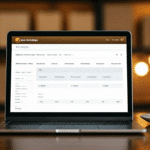Weighted Average Cost Inventory Valuation: Optimizing Inventory Management for Ecommerce Businesses
Effective inventory management is crucial for the success of any ecommerce business. Among the various methods available for valuing inventory, the weighted average cost (WAC) inventory valuation stands out for its balance of simplicity and accuracy. This article delves into the intricacies of WAC, its implementation, advantages, common pitfalls, and its impact on your bottom line, supported by the latest data and insights.
Table of Contents
- What is Weighted Average Cost Inventory Valuation?
- Advantages of Weighted Average Cost Valuation
- Implementing WAC in Your Ecommerce Business
- Common Mistakes to Avoid
- Impact on Your Bottom Line
- The Role of Technology
- Comparing WAC to Other Valuation Methods
- Conclusion
What is Weighted Average Cost Inventory Valuation?
The weighted average cost (WAC) inventory valuation method calculates the average cost of all goods available for sale during a specific period. This is achieved by analyzing both the purchase price and the quantity of each inventory item. The formula for WAC is:
WAC = Total Cost of Goods Available for Sale / Total Units Available for Sale
For instance, if you have 100 units of Product A purchased at $10 each and 200 units of Product B purchased at $15 each, the WAC would be:
(100 x $10 + 200 x $15) / (100 + 200) = ($1,000 + $3,000) / 300 = $13.33 per unit
This average cost becomes the basis for valuing inventory and calculating the cost of goods sold (COGS).
Advantages of Weighted Average Cost Valuation
Simplicity and Efficiency
WAC is praised for its simplicity compared to methods like First-In, First-Out (FIFO) and Last-In, First-Out (LIFO). It doesn't require tracking the cost of individual inventory items, making it easier to manage, especially for businesses with large inventories.
Cost Fluctuation Mitigation
By averaging costs, WAC smooths out price fluctuations, providing a more stable COGS over time. This can lead to more consistent profit margins and easier financial forecasting.
Compliance and Standardization
WAC is accepted under various accounting standards, including Generally Accepted Accounting Principles (GAAP) and International Financial Reporting Standards (IFRS), ensuring compliance and facilitating reporting.
Implementing Weighted Average Cost in Your Ecommerce Business
Data Collection and Calculation
Begin by gathering data on all inventory purchases, including quantities and purchase prices. Use the WAC formula to calculate the average cost periodically, such as monthly or quarterly.
Accounting Software Integration
Integrate WAC into your accounting system. Popular accounting software like QuickBooks, Xero, and Wave Accounting support WAC, automating calculations and reducing manual errors.
Regular Inventory Audits
Conduct regular physical inventory counts to ensure that the recorded inventory matches actual stock. This helps maintain accuracy in WAC calculations and financial statements.
Common Mistakes to Avoid When Implementing WAC
Inconsistent Application
Applying WAC inconsistently across different inventory items can lead to inaccuracies. Ensure that WAC is uniformly applied to all applicable inventory unless specific items require a different valuation method.
Neglecting Software Updates
Failing to update your accounting software to reflect changes in inventory can result in incorrect WAC calculations. Regularly update and maintain your software to align with your inventory management practices.
Ignoring Market Conditions
WAC may not account for significant market changes affecting inventory costs. Monitor market trends and be prepared to adjust your inventory valuation method if necessary.
How Weighted Average Cost Affects Your Bottom Line
Profitability
By stabilizing COGS, WAC can lead to more predictable profit margins. This predictability aids in strategic planning and financial management.
Tax Implications
The choice of inventory valuation method can impact taxable income. While WAC offers a balanced approach, it's essential to consult with a tax professional to understand its specific implications for your business.
Financial Reporting
Accurate inventory valuation through WAC enhances the reliability of financial statements, which is crucial for stakeholders, investors, and potential financing opportunities.
The Role of Technology in Implementing Weighted Average Cost
Automated Calculations
Modern accounting and inventory management software automate WAC calculations, reducing the risk of human error and saving time. Tools like NetSuite and Shopify Inventory offer robust features for managing WAC.
Real-Time Tracking
Technology enables real-time tracking of inventory levels and costs, providing up-to-date data that enhances decision-making and operational efficiency.
Data Analytics and Insights
Advanced analytics tools can analyze WAC data to identify trends, optimize pricing strategies, and improve inventory turnover rates, contributing to overall business growth.
Comparing Weighted Average Cost to Other Inventory Valuation Methods
Weighted Average Cost vs. FIFO
FIFO prioritizes selling the oldest inventory first, which can be advantageous during periods of rising prices as it results in lower COGS and higher profits. However, WAC offers a more balanced approach by averaging costs, which can provide more stable financial results.
Weighted Average Cost vs. LIFO
LIFO assumes the latest inventory purchased is sold first, which can be beneficial for tax purposes in inflationary environments by matching current higher costs against revenues. WAC, on the other hand, smooths out these variations, offering a middle ground between FIFO and LIFO.
Choosing the Right Method
The optimal inventory valuation method depends on your business model, industry standards, and financial goals. For ecommerce businesses with diverse and fluctuating inventory costs, WAC provides a reliable and efficient solution. However, consulting with a financial advisor can help determine the best fit for your specific needs.
Conclusion
The weighted average cost inventory valuation method offers ecommerce businesses a streamlined and effective approach to managing inventory costs. By averaging out price fluctuations, WAC provides stability in financial reporting and profitability. Implementing WAC requires accurate data collection, reliable accounting software, and disciplined inventory management practices. While it may not be the ideal method for every business scenario, WAC stands out for its balance of simplicity and accuracy, making it a valuable tool for many ecommerce operations.
As the ecommerce landscape continues to evolve, staying informed about inventory valuation methods and leveraging technology will be key to maintaining a competitive edge and ensuring long-term success.
For more in-depth insights and professional advice, consider consulting the Accounting Tools or the Investopedia resources.




















